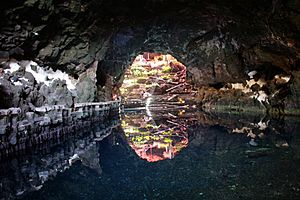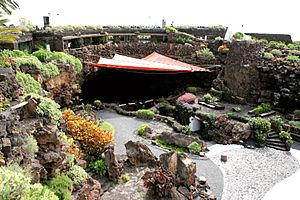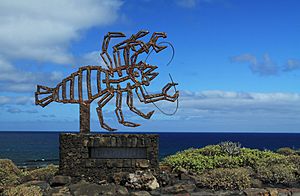Jameos del Agua facts for kids
Jameos del Agua is a really cool place in Lanzarote, one of the Canary Islands in Spain. It's made from amazing lava caves! A famous local artist and architect named César Manrique helped turn it into a special center for art, culture, and tourism.
At Jameos del Agua, you can explore a secret underground salt lake. There's also a restaurant, beautiful gardens, a bright green pool, a museum, and even an auditorium. It's a unique spot where nature and art come together.
Contents
How Jameos Formed
The word "jameo" comes from an old local language. It means a big opening in a lava tube. A lava tube is like a tunnel formed when hot lava flows. The outside cools and hardens, but the lava inside keeps flowing. When the lava drains away, it leaves a hollow tunnel. If parts of the roof fall in, it creates these "jameos" or openings.
Jameos del Agua is part of a huge volcanic tunnel. This tunnel was created by an eruption from the Monte Corona volcano. The whole tunnel is about 6 kilometers (almost 4 miles) long. A big part of it, about 1.5 kilometers (nearly a mile), goes under the sea! Because of this, it's sometimes called the "Tunnel of Atlantis."
Jameos del Agua has at least three main openings or caves:
- Jameo Chico: This is where you enter the inside part.
- Jameo Grande: A larger open area.
- Jameo la Cazuela: Another part of the cave system.
César Manrique's Vision
César Manrique, a talented artist from Lanzarote, had a special idea for Jameos del Agua. He wanted to create a place where visitors could enjoy the natural beauty of the lava caves. He aimed to blend nature with artistic design. This was the very first art, culture, and tourism center he created. It shows his belief that nature and art can live in harmony.
In the early 1960s, the site was abandoned and needed a lot of work. César Manrique and his team cleaned and restored it. The first parts of Jameos del Agua opened to the public in 1966. The unique shape of the volcanic tunnel meant that the project changed over time. New ideas and solutions were always being found.
The main structure of Jameos del Agua was finished in 1977. This included the auditorium, which also officially opened then. Later, more facilities were added. One of these was a museum called "Casa de los Volcanes." Since 1987, this museum has focused on science and volcanology, which is the study of volcanoes.
The Blind Lobster
Jameos del Agua is very important for nature. It's home to a super rare animal called the blind lobster. Its scientific name is Munidopsis polymorpha. This tiny creature is yellow-white and only about one centimeter long. As its name suggests, it cannot see.
These special lobsters are very sensitive. They don't like changes in the water, noise, or bright lights. They are also very sensitive to rust, which can even harm or kill them. That's why it's super important not to throw coins into the water. It helps keep these unique lobsters safe!
Protecting Jameos del Agua
The area around Monte Corona, which includes Jameos del Agua, is a protected natural monument. It was recognized as an important scientific site in 1994. This means it's considered a fragile area that needs special care to protect its unique geology and wildlife.
See also
- Timanfaya National Park
- In Spanish: Jameos del Agua para niños





